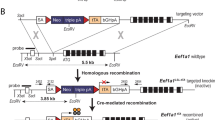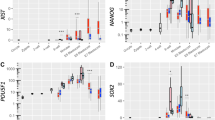Abstract
During development of the female mouse embryo, one of the two X chromosomes is inactivated in a random manner in most cell lineages1. However, in the extraembryonic trophectoderm and primary endoderm lineages there is preferential inactivation of the paternally derived X chromosome2–4. The inactivated X chromosomes of the extraembryonic and somatic tissues appear equally inactive at the level of the expression of X-linked genes2–7. However, there are differences in the timing of their replication8–10 and the extent of DNA modification as determined by gene transfer11–15. The identification of transgenic animals carrying X-linked modified α-fetoprotein (AFP) genes allowed us to examine whether the inactivation process extends to an autosomal gene which is normally expressed at high levels in specific extraembryonic and somatic cells, and if so, whether the inactivation process is different in these two tissues. Our results demonstrate that the X-linked AFP genes were expressed on the inactive X chromosome in the visceral endoderm of the yolk sac but not in fetal liver. Thus, the transcriptional activity of the AFP minigene on the inactive X chromosome is dependent on the tissue in which it resides, and most probably reflects differences in the nature of the maintenance of the inactive state of the extraembryonic and embryonic X chromosomes.
This is a preview of subscription content, access via your institution
Access options
Subscribe to this journal
Receive 51 print issues and online access
$199.00 per year
only $3.90 per issue
Buy this article
- Purchase on Springer Link
- Instant access to full article PDF
Prices may be subject to local taxes which are calculated during checkout
Similar content being viewed by others
References
Lyon, M. F. Nature 190, 372–373 (1961).
Takagi, N. & Sasaki, M. Nature 256, 640–642 (1975).
West, J. D., Frels, W. I., Chapman, V. M. & Papaioannou, V. E. Cell 12, 873–882 (1977).
Papaioannou, V. E. & West, J. D. Genet. Res. Camb. 37, 183–197 (1981).
McMahon, A., Forsten, M. & Monk, M. J. Embryol. exp. Morph. 64, 251–258 (1981).
McMahon, A., Forsten, M. & Monk, M. J. Embryol. exp. Morph. 74, 207–220 (1983).
McMahon, A. & Monk, M. Genet. Res. Camb. 41, 69–83 (1983).
Takagi, N. Expl Cell Res. 86, 127–135 (1974).
Sugawara, O., Takagi, N. & Sasaki, M. Chromosoma 88, 133–138 (1983).
Disteche, C. M., Eicher, E. M. & Latt, S. A. Expl Cell Res. 133, 357–362 (1981).
Liskay, R. M. & Evans, R. J. Proc. natn. Acad. Sci. U.S.A. 77, 4895–4898 (1980).
Chapman, V. M. et al. Proc. natn. Acad. Sci. U.S.A. 79, 5357–5361 (1982).
Lester, S.C., Korn, N. J. & DeMars, R. Somatic Cell Genet. 8, 265–284 (1982).
Venolia, L. et al. Proc. natn. Acad. Sci. U.S.A. 79, 2352–2354 (1982).
Kratzer, P. G., Chapman, V. M., Lambert, H., Evans, R. E. & Liskay, R. M. Cell 33, 37–42 (1983).
Krumlauf, R., Hammer, R. E., Tilghman, S.M. & Brinster, R. L. Molec. cell. Biol. 5, 1639–1648 (1985).
Scott, R. W., Vogt, T. F., Croke, M.E. & Tilghman, S. M. Nature 310, 562–567 (1984).
Phillips, S. J., Birkenmeier, E. H., Callahan, R. & Eicher, E. M. Nature 297, 241–242 (1982).
Nielsen, J. T. & Chapman, V. M. Genetics 87, 319–325 (1977).
Chapman, V. M., Kratzer, P. G. & Quarantillo, B. A. Genetics 103, 785–795 (1983).
Lyon, M. F., Searle, A. G., Ford, C. E. & Ohno, S. Cytogenetics 3, 306–323 (1964).
Takagi, N. Chromosoma 81, 439–445 (1980).
Russell, L. B. & Montgomery, C. S. Genetics 64, 281–312 (1970).
Russell, L. B. Science 140, 976–978 (1963).
Ohno, S. & Lyon, M. F. Chromosoma 16, 90–100 (1965).
Young, P. R. & Tilghman, S. M. Molec. Cell Biol 4, 898–907 (1984).
Sanford, J. P., Chapman, V. M. & Rossant, J. Trends Genet. 1, 89–93 (1985).
Levak-Svajger, B., Svajger, A. & Skreb, N. Experientia 25, 1311–1312 (1969).
Author information
Authors and Affiliations
Rights and permissions
About this article
Cite this article
Krumlauf, R., Chapman, V., Hammer, R. et al. Differential expression of α-fetoprotein genes on the inactive X chromosome in extraembryonic and somatic tissues of a transgenic mouse line. Nature 319, 224–226 (1986). https://doi.org/10.1038/319224a0
Received:
Accepted:
Issue Date:
DOI: https://doi.org/10.1038/319224a0
This article is cited by
-
Homologous illegitimate random integration of foreign DNA into the X chromosome of a transgenic mouse line
BMC Molecular Biology (2010)
-
Difference between random and imprinted X inactivation in common voles
Chromosoma (2010)
-
Long-range cis effects of ectopic X-inactivation centres on a mouse autosome
Nature (1997)
-
Coordinate control and variation in X-linked gene expression among female mice
Mammalian Genome (1997)
-
Restricted tissue-specific but correct developmental expression mediated by a short human α1AT promoter fragment in transgenic mice
Transgenic Research (1995)
Comments
By submitting a comment you agree to abide by our Terms and Community Guidelines. If you find something abusive or that does not comply with our terms or guidelines please flag it as inappropriate.



